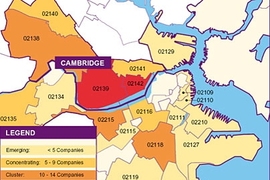Preliminary findings of a new study of the life sciences industry in Massachusetts initiated by the Massachusetts Institute of Technology and the Massachusetts Biotechnology Council show that the life sciences industry continues to grow in eastern Massachusetts, with more than half of the companies in Boston and Cambridge located in just three Cambridge zip codes.
The new study, known as the Mass Impact study, will examine the economic impact and growth of the life sciences industry throughout Massachusetts, with the related goals of providing a current comprehensive inventory of the industry; establishing a foundation for a wide variety of comparative studies; and developing economic impact metrics that can be updated on a regular basis.
Mass Impact will build on the MassBiotech 2010 study completed in 2002 by the Massachusetts Biotechnology Council and a number of other related MIT studies. It also will incorporate data from the medical devices sector and other life sciences firms not covered in the 2010 study.
The 2010 study pointed out opportunities for Massachusetts to achieve global leadership in the biotech sector and identified obstacles that could hinder growth, especially in the midst of stiff competition from other states, including California and North Carolina. A number of the policy objectives set out in that report have already been achieved, such as enhanced tax legislation and streamlined permitting. The new study will incorporate additional data across both publicly traded and private firms and provide enhanced analysis and trend development.
The study will include life sciences companies, ancillary organizations, universities, hospitals, investors, trade organizations and professional services that have a specialized life sciences focus. The life sciences industry, for the purposes of the study, includes companies that are pursuing innovation in such areas as biotechnology, bioinformatics, medical devices, genomics, pharmaceuticals, specialty materials and related areas.
Massachusetts has earned a reputation as one of the foremost clusters for the life sciences industry in the world. Life science companies are founded in this region because of access to a talented pool of researchers, innovators and professionals experienced in the process of bringing a product to market. In turn, this pool of talented industry experts and the companies they create have attracted companies from outside the region with a goal of capturing some of that innovation within their own research and development efforts. The proximity of a number of major research universities, teaching hospitals, and venture capital firms contributes greatly to the mix of human, physical and financial assets forming the basis of this cluster.
The full-scale report will be released later this year. For further information or to participate in the study, please contact MASSImpact@sloan.mit.edu.






